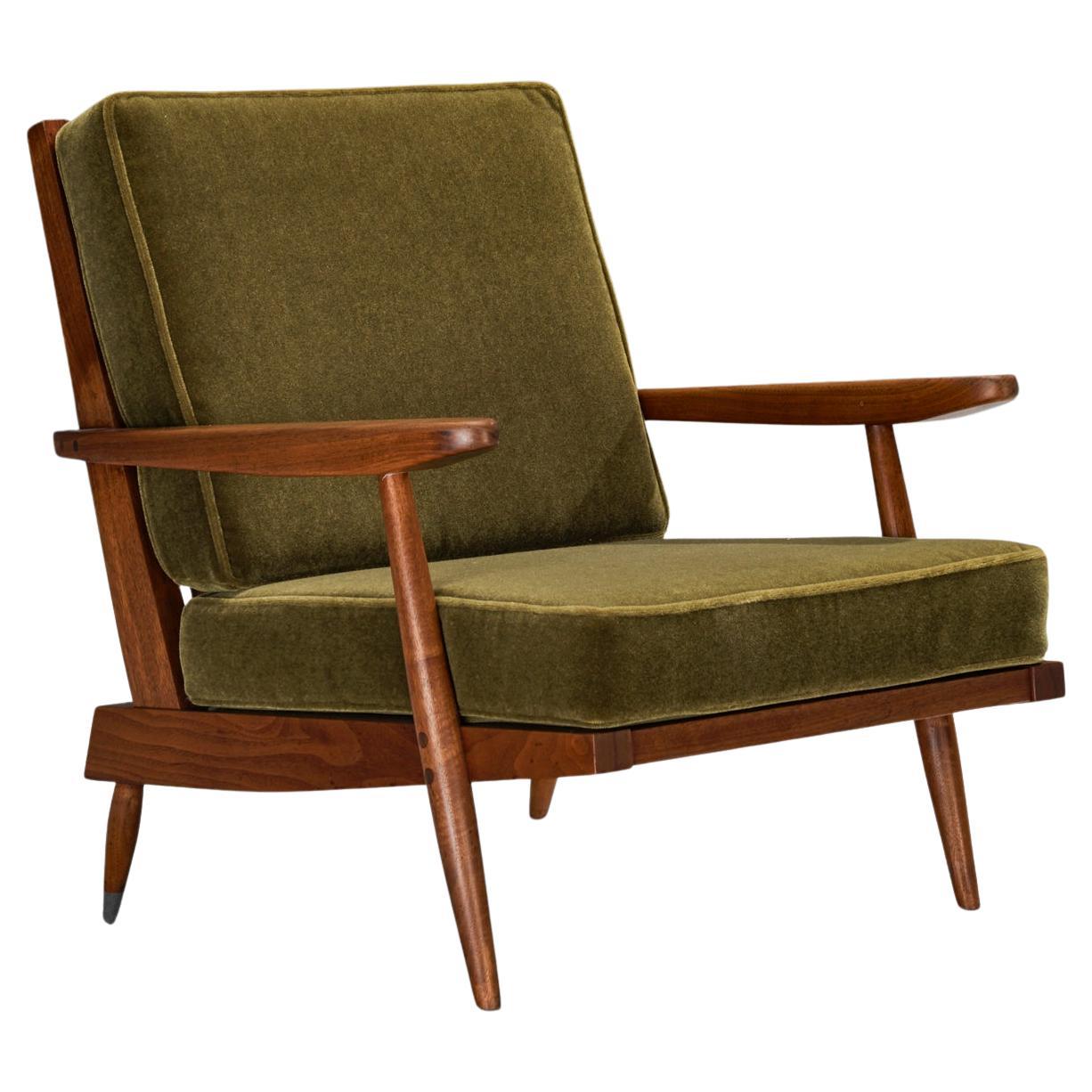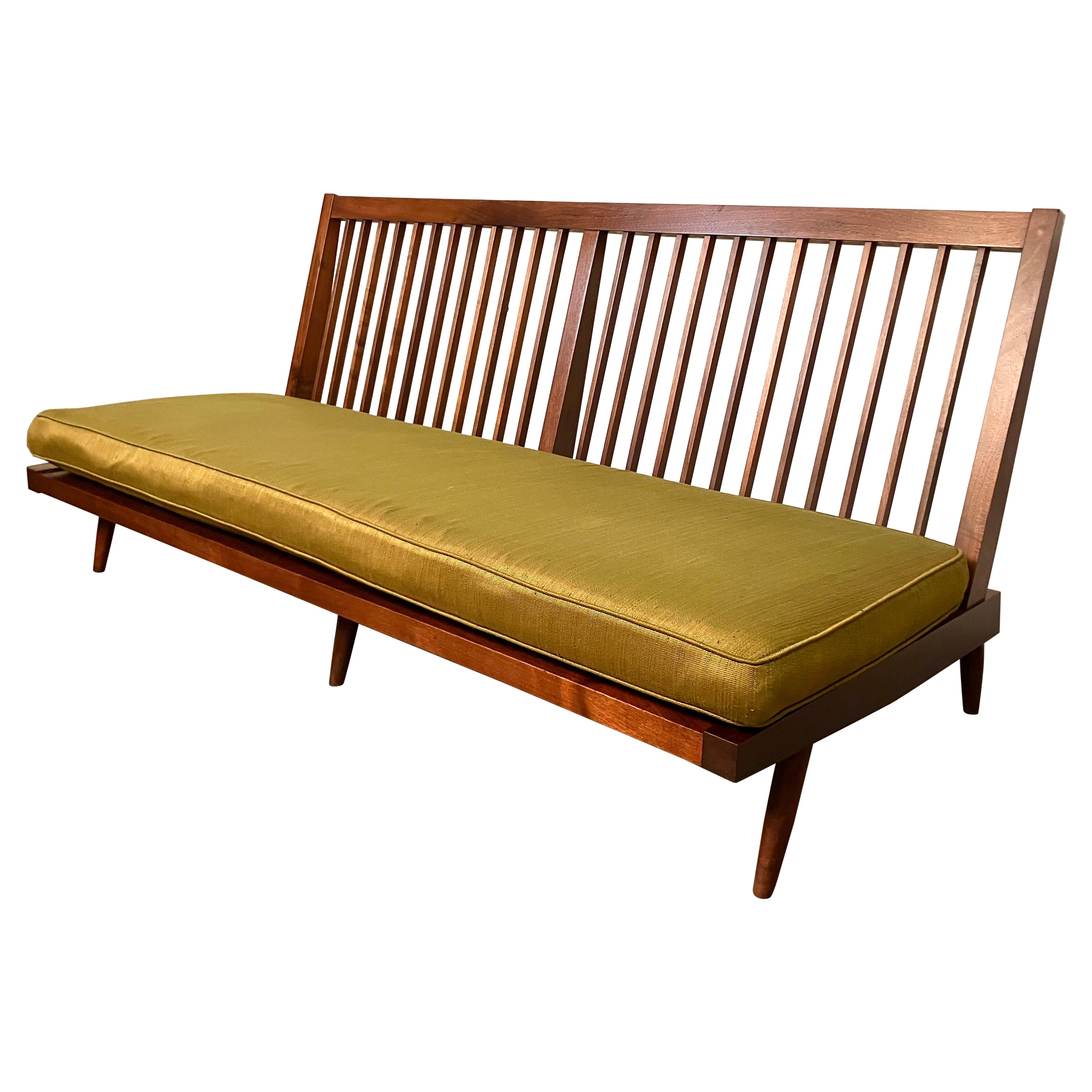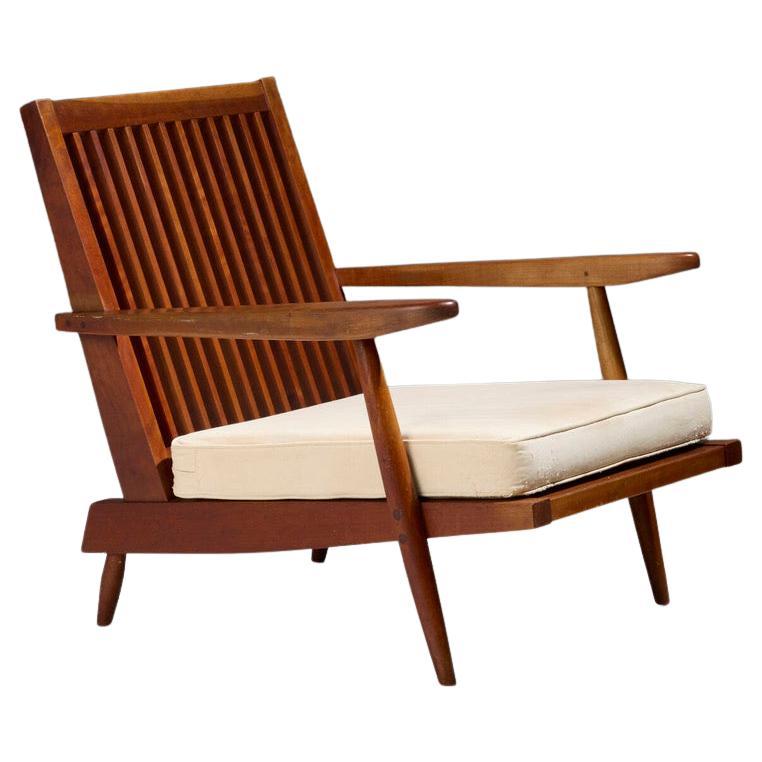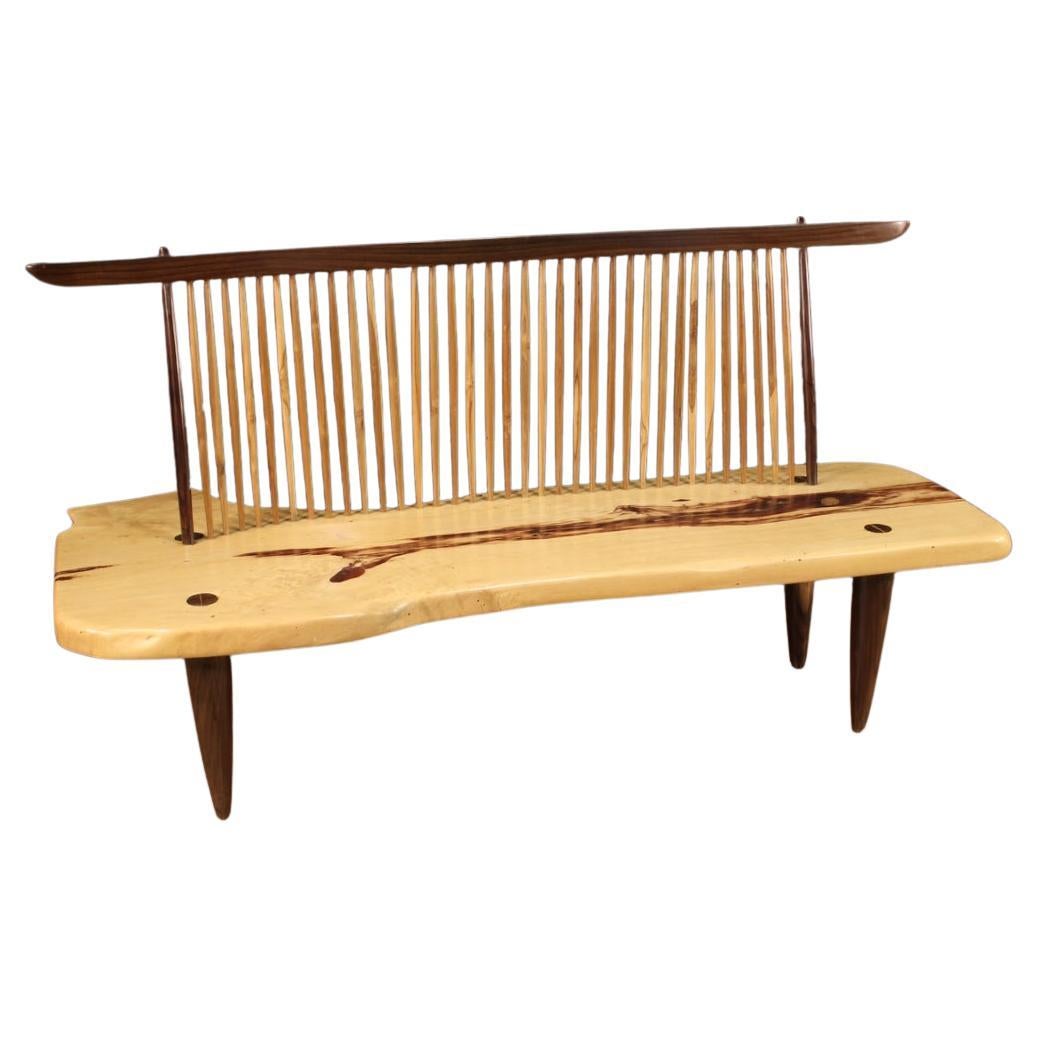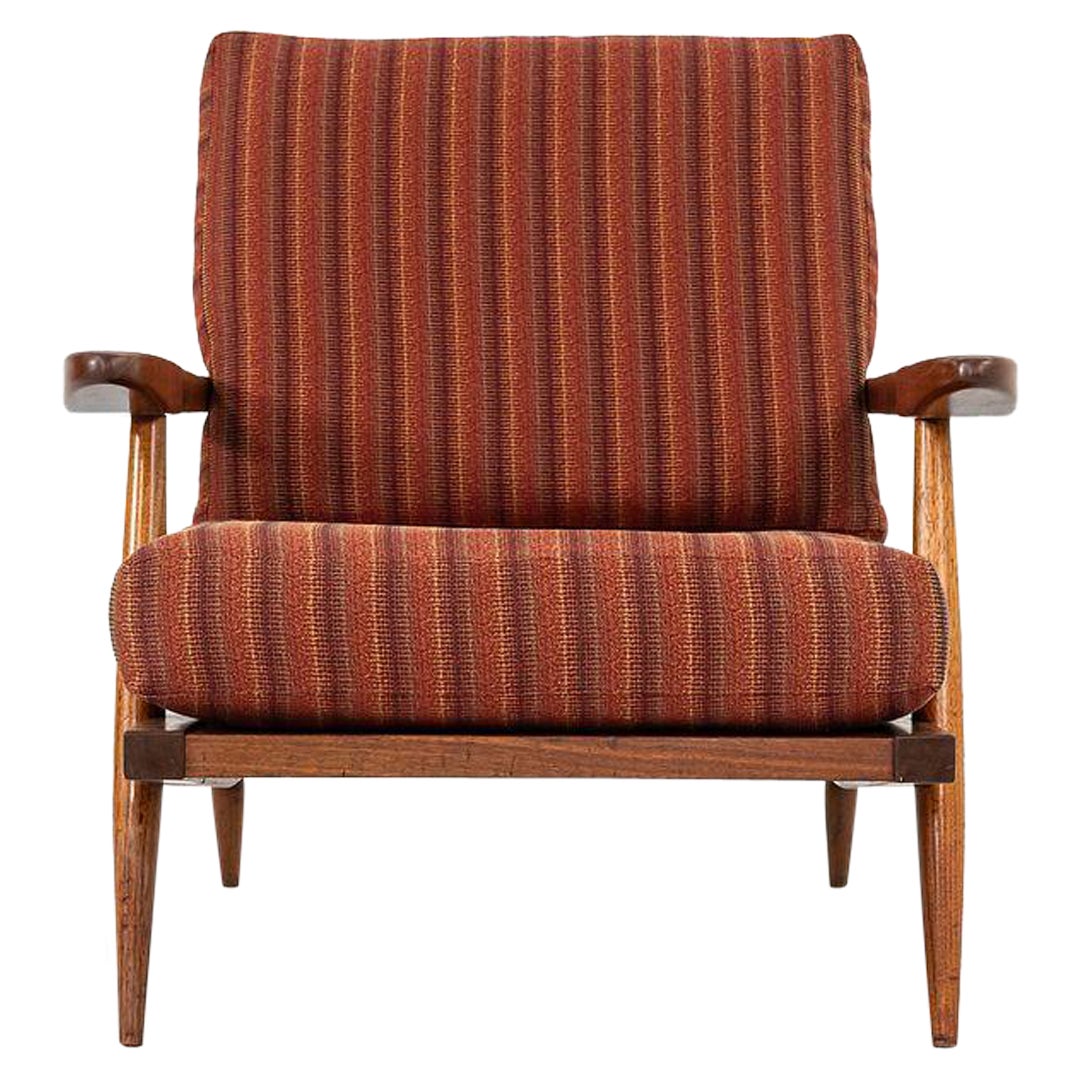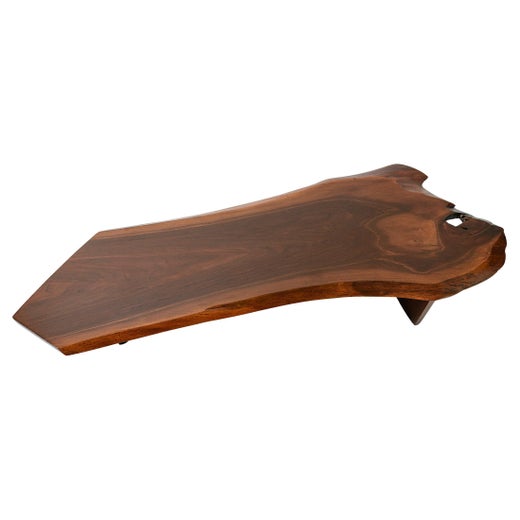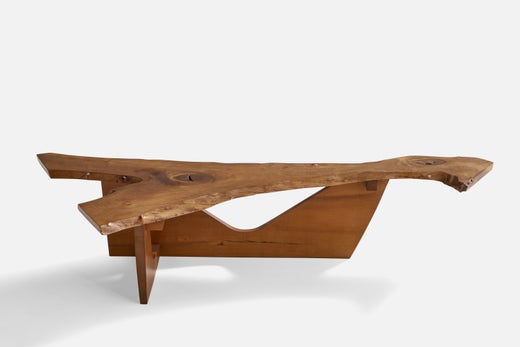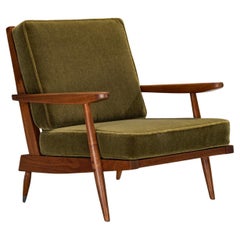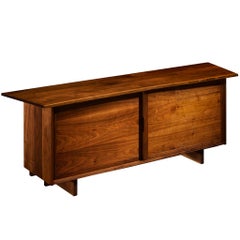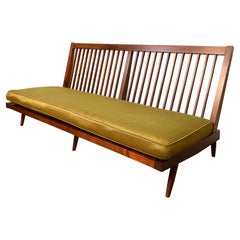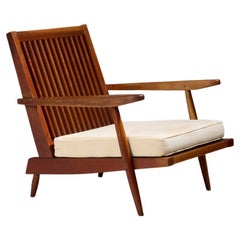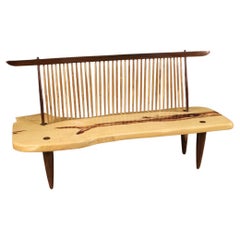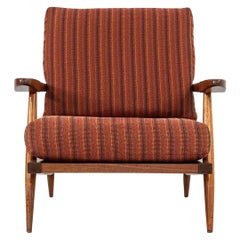George Nakashima Spindleback Sofa in American Walnut and Bicolor Mohair
Acerca del artículo
- Creador:George Nakashima Studio (Taller/Estudio),George Nakashima (Diseñador)
- Dimensiones:Altura: 80 cm (31,5 in)Anchura: 258 cm (101,58 in)Profundidad: 89 cm (35,04 in)Altura del asiento: 41 cm (16,15 in)
- Estilo:Moderno de mediados de siglo (Del período)
- Materiales y técnicas:
- Lugar de origen:
- Época:
- Fecha de fabricación:1959
- Estado:Desgaste acorde con la edad y el uso. Every item Morentz offers is checked by our team of 30 craftspeople in our in-house workshop. Special restoration or reupholstery requests can be done. Check ‘About the item’ or ask our design specialists for detailed information on the condition.
- Ubicación del vendedor:Waalwijk, NL
- Número de referencia:Vendedor: 501108851stDibs: LU933145246292
George Nakashima
Maestro carpintero y arquitecto formado en el M.I.T., George Nakashima fue la figura más destacada del movimiento estadounidense de mobiliario Studio. Junto con Wharton Esherick, Sam Maloof y Wendell Castle, Nakashima era un artesano que desdeñaba los métodos y materiales industriales en favor de un enfoque personal y artesanal del diseño de sillas, mesas de centro y otras piezas. Lo que distingue a Nakashima es el estilo poético de su obra, su veneración por la madera y la creencia de que sus muebles podían evocar -como él mismo dijo en el título de sus memorias de 1981- El alma de un árbol.
Nacido en Spokane (Washington), hijo de inmigrantes japoneses, Nakashima viajó mucho después de la universidad, trabajando y estudiando en París, Japón y la India, y en cada parada absorbió tanto las influencias del modernismo de como las del diseño tradicional.
El punto de inflexión en el desarrollo de la carrera de Nakashima se produjo en Estados Unidos en 1942, cuando fue internado en un campo para asiático-americanos en Idaho. Allí, Nakashima conoció a un maestro tallador de madera que le instruyó en las técnicas artesanales japonesas. Un antiguo empleador consiguió la liberación de Nakashima y lo llevó a la bucólica New Hope, Pensilvania, donde Nakashima montó un estudio y trabajó el resto de su vida. (La maestra artesana Mira Nakashima mantiene vivo el legado de su padre en el George Nakashima Studio de New Hope en la actualidad. Desde la muerte de su padre, en 1990, es la directora artística de George Nakashima Woodworkers ).
La singular estética de Nakashima se plasma mejor en sus mesas a medida y sus bancos - piezas que muestran las vetas, rebabas y verticilos de una tabla de madera. Dejó el "borde libre", o contorno natural, de la losa sin cepillar, y reforzó las fisuras de la madera con juntas "mariposa".
Casi todas las piezas de asiento de Nakashima tienen los bordes lisos y fresados. Nakashima también contrató a grandes fabricantes para producir ediciones cuidadosamente supervisadas de sus diseños. Knoll lleva ofreciendo su Silla recta -una versión moderna de la silla Windsor con respaldo de husillo - desde 1946; la desaparecida empresa Widdicomb-Mueller, resultado de la fusión entre Widdicomb y Mueller Furniture, publicó en los años 50 la colección Origins, inspirada en la Shaker.
En 1973, Nelson Rockefeller hizo a Nakashima su mayor encargo: una suite de 200 piezas para su finca de los suburbios de Nueva York. En la actualidad, los muebles de Nakashima son coleccionados tanto por como por los más modernos: sus obras forman parte de las colecciones del Philadelphia Museum of Art, el Metropolitan Museum of Art de Nueva York y el Smithsonian Institution, así como de las casas de Steven Spielberg, Brad Pitt, Diane von Furstenberg y el difunto Steve Jobs.
Encuentra muebles vintage de George Nakashima a la venta en 1stDibs.
George Nakashima Studio
Maestro carpintero y arquitecto formado en el M.I.T., George Nakashima fue la figura más destacada del movimiento estadounidense de mobiliario Studio. Junto con Wharton Esherick, Sam Maloof y Wendell Castle, Nakashima era un artesano que desdeñaba los métodos y materiales industriales en favor de un enfoque personal y artesanal del diseño de sillas, mesas de centro y otras piezas. Lo que distingue a Nakashima es el estilo poético de su obra, su veneración por la madera y la creencia de que sus muebles podían evocar -como él mismo dijo en el título de sus memorias de 1981- El alma de un árbol.
Nacido en Spokane (Washington), hijo de inmigrantes japoneses, Nakashima viajó mucho después de la universidad, trabajando y estudiando en París, Japón y la India, y en cada parada absorbió tanto las influencias del modernismo de como las del diseño tradicional.
El punto de inflexión en el desarrollo de la carrera de Nakashima se produjo en Estados Unidos en 1942, cuando fue internado en un campo para asiático-americanos en Idaho. Allí, Nakashima conoció a un maestro tallador de madera que le instruyó en las técnicas artesanales japonesas. Un antiguo empleador consiguió la liberación de Nakashima y lo llevó a la bucólica New Hope, Pensilvania, donde Nakashima montó un estudio y trabajó el resto de su vida. (La maestra artesana Mira Nakashima mantiene vivo el legado de su padre en el George Nakashima Studio de New Hope en la actualidad. Desde la muerte de su padre, en 1990, es la directora artística de George Nakashima Woodworkers ).
La singular estética de Nakashima se plasma mejor en sus mesas a medida y sus bancos - piezas que muestran las vetas, rebabas y verticilos de una tabla de madera. Dejó el "borde libre", o contorno natural, de la losa sin cepillar, y reforzó las fisuras de la madera con juntas "mariposa".
Casi todas las piezas de asiento de Nakashima tienen los bordes lisos y fresados. Nakashima también contrató a grandes fabricantes para producir ediciones cuidadosamente supervisadas de sus diseños. Knoll lleva ofreciendo su Silla recta -una versión moderna de la silla Windsor con respaldo de husillo - desde 1946; la desaparecida empresa Widdicomb-Mueller, resultado de la fusión entre Widdicomb y Mueller Furniture, publicó en los años 50 la colección Origins, inspirada en la Shaker.
En 1973, Nelson Rockefeller hizo a Nakashima su mayor encargo: una suite de 200 piezas para su finca de los suburbios de Nueva York. En la actualidad, los muebles de Nakashima son coleccionados tanto por como por los más modernos: sus obras forman parte de las colecciones del Philadelphia Museum of Art, el Metropolitan Museum of Art de Nueva York y el Smithsonian Institution, así como de las casas de Steven Spielberg, Brad Pitt, Diane von Furstenberg y el difunto Steve Jobs.
Encuentra muebles de George Nakashima Studio a la venta en 1stDibs.
Fundada en 2006, Morentz cuenta con un equipo de unos 55 restauradores, tapiceros, asesores de interiores e historiadores del arte, lo que la convierte en una galería, taller y estudio de tapicería, todo en uno. Cada día, un conjunto cuidadosamente seleccionado de muebles del siglo XX llega de todo el mundo al almacén de la empresa, donde el equipo examina minuciosamente cada pieza para determinar qué trabajo hay que hacer, si es que hay que hacer alguno. Tanto si se trata de una nueva tapicería como de una restauración completa, el objetivo de Morentz es siempre honrar la intención del diseñador y, al mismo tiempo, satisfacer los deseos del cliente. El equipo está a la altura de cualquier reto, desde restaurar una sola pieza a su gloria original hasta amueblar un proyecto hotelero a gran escala.
- EnvíoRecuperando presupuesto…Envío desde: Waalwijk, Países Bajos
- Política de devolución
Más de este vendedor
Ver todoVintage, Década de 1950, Estadounidense, Moderno de mediados de siglo, S...
Tela, Nogal
Vintage, Década de 1950, Estadounidense, Moderno de mediados de siglo, S...
Tela, Nogal
Vintage, Década de 1960, Estadounidense, Moderno de mediados de siglo, A...
Pecán, Nogal
Vintage, Década de 1950, Estadounidense, Moderno de mediados de siglo, S...
Tela, Nogal
Vintage, Década de 1980, Estadounidense, Moderno de mediados de siglo, M...
Nogal
Vintage, Década de 1960, Estadounidense, Moderno de mediados de siglo, A...
Nogal
También te puede gustar
Vintage, Década de 1960, Estadounidense, Moderno de mediados de siglo, S...
Tela, Tapicería, Madera, Madera dura, Nogal
Vintage, Década de 1960, Estadounidense, Sillones
Lino, Cereza
Vintage, 1980s, American, Sofás
Madera
Vintage, Década de 1950, Estadounidense, Moderno, Sofás
Tela, Espuma, Nogal
Vintage, Década de 1950, Estadounidense, Moderno, Sofás
Tela, Espuma, Nogal
2.º década del siglo XXI, Estadounidense, Sofás
Mohair, Nogal
